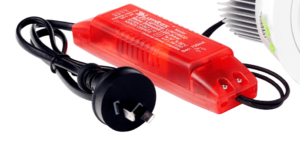Do LED’s work with “drivers” or “transformers?” Short answer, it depends on the design configuration….Most mains operated LED downlights commonly available in Australia today need a driver, which is a collection of electronics that delivers a trickle of DC current to the LED chips to make them illuminate.
A primary function of the driver circuit is to limit the amount of current consumed by the LED, otherwise it will rapidly self destruct.
A driver may be similar in appearance to the traditional transformer attached to the old halogen lamps that we are familiar with. However, they cannot be interchanged.
A transformer for halogen lamps generally provides a low, often unregulated voltage to the lamp and does not limit the current.
Applying a standard Constant Voltage Transformer to a LED that was designed for a Constant Current Driver is likely to result in damage to the LED. Consequently, careful selection of the power supply is critical to ensuring longevity for the LED.
Compact “drivers” are built into the base of most LED lamps. This answers a question we often asked, being “why don’t lamps need drivers.” In fact, every LED needs some type of voltage regulation to deliver reliable operation.
As we progress to “driverless” technology these challenges of choosing exernal power supplies should lessen. Note that even “driverless” technology means there is still a driver in there somewhere, but those components are likely integrated within the circuitry of the light fitting. Once again, LEDs still need a regulated trickle of DC current, however that may be delivered.







